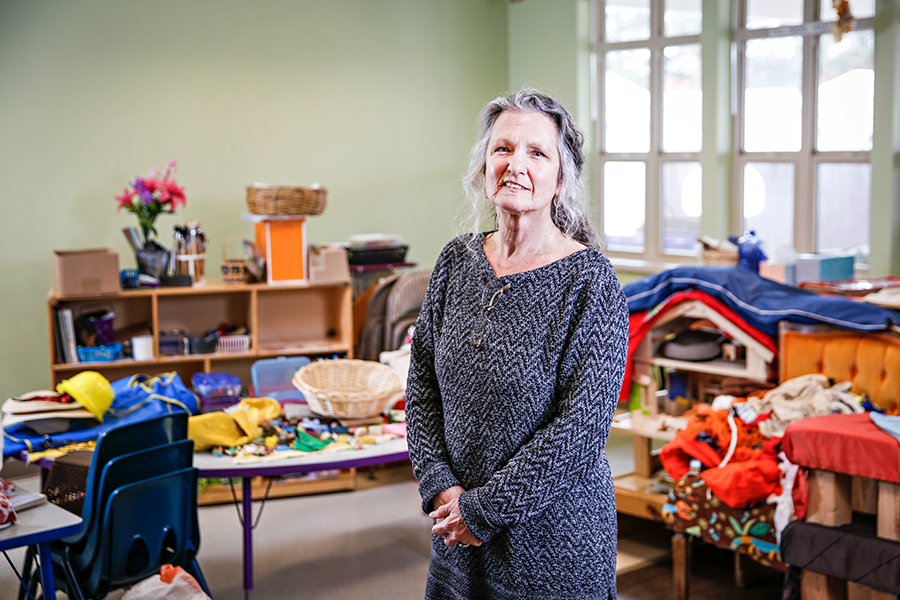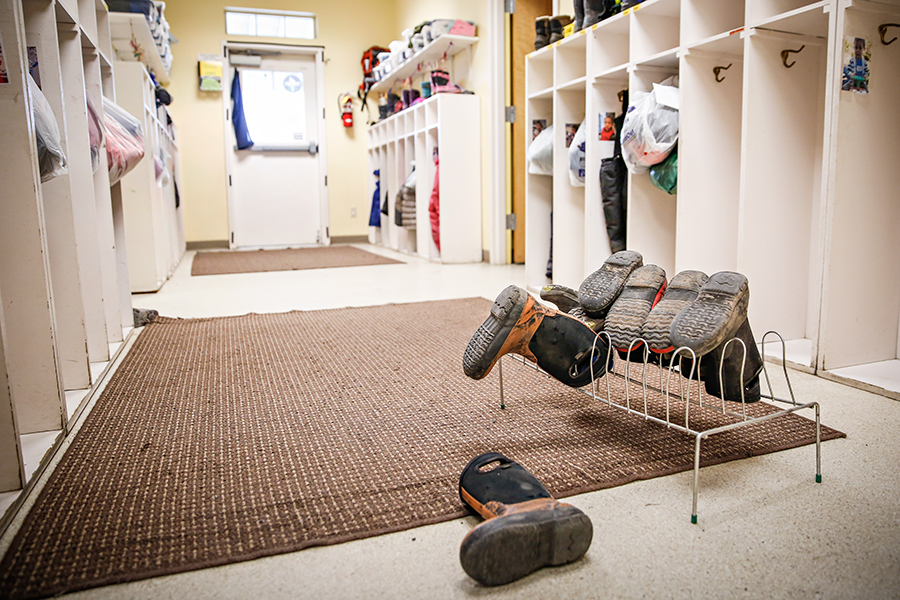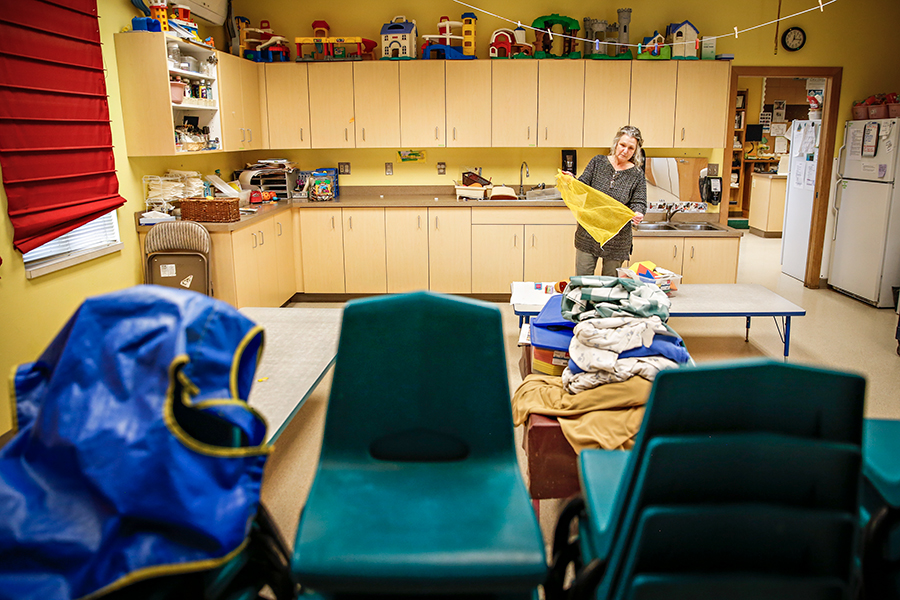Pandemic Upending Childcare Industry and Workforce that Depends on It
Widespread closures are disrupting families and employers; advocates worry the industry won’t recover and call for rethinking public childcare funding
By Myers Reece
In a March 11 letter to Congress, 39 organizations, including the nation’s most prominent childcare advocacy groups, requested emergency relief for the childcare industry to be included in the federal government’s COVID-19 stimulus package.
“Child care is the backbone of our nation’s economy,” the letter stated. “Without it, millions of parents cannot go to work or attend school, and the U.S. economy suffers billions of dollars in losses.”
A week later, the executive director of a childcare advocacy group called First Five Years Fund attached an ominous prediction to the funding plea.
“Without it, the child care industry will collapse,” Sarah Rittling said, echoing an estimation from the National Association for the Education of Young Children (NAEYC) and Early Care and Education Consortium (ECEC) that more than half of the nation’s licensed childcare facilities could close without relief.
Although the industry didn’t get the $50 billion in relief sought by the NAEYC and ECEC, it did receive $3.5 billion in emergency block grants. Advocacy groups cheered the money but said it was not enough to ensure a viable post-pandemic industry.
The very need for emergency relief highlighted an industry reality: While childcare is considered indispensable for the U.S. workforce, as made clear during the pandemic, it’s not uniformly governed or funded as a public service like K-12 schools are. States tailor their own funding and subsidization plans, incorporating federal dollars from sources such as the Child Care and Development Block Grant. There are also federal low-income programs like Head Start.
Montana has limited state funding for childcare and early childhood education. Service providers in those fields are broadly private and overly dependent upon tuition, advocates say, with minimal relief for both providers and families. Montana is also one of the only states in the country without state-funded preschool.
When Gov. Steve Bullock shut down public schools in response to COVID-19, childcare facilities were not included in the mandatory closures, similar to other states who have either left childcare open as a necessary service or geared their guidelines specifically toward childcare for workers deemed essential, such as those in health care. In a March 24 press conference announcing the extension of public school closures, Bullock noted the critical role that childcare plays in the workforce.
“Many Montanans continue to provide valuable, essential services and they need access to child care,” Bullock said.
As of March 30, childcare was still not required to close in Montana, although providers said there was lack of clarity over the types of facilities, adding to a litany of questions rendered by the pandemic, including: If it’s unsafe to keep public schools open, is it safe for daycares to continue running? How do you keep 3-year-olds six feet apart all day? And, in the absence of a government mandate, what should we do?

Numerous providers decided the answer to that last question was to shut down, in accordance with guidelines from various national childcare advocacy groups who recommend following K-12 closures. Other operations still have their doors open to varying degrees, with precautionary measures in place, in an effort to continue serving families and maintain their only source of income.
“There are all these national recommendations, but from a state level, up to this point, it’s basically been: ‘You’re your own business; you get to choose,’” said Kalie Adoretti of The Nurturing Center, the childcare resource and referral agency for Northwest Montana based in Kalispell. “There’s some mixed information out there. It’s been tough for childcare. There’s a very gray area on how to move forward.”
EdSource, a journalism nonprofit focused on education issues, reported on March 18 that a “disproportionate number of family child care providers nationwide are remaining open, either because local governments have asked them to do so, or because of the needs of parents or the providers themselves,” according to Christie Balka, policy director of All Our Kin, a childcare advocacy organization.
“We don’t want any child care provider or, frankly, any family to feel like they have to choose between following health recommendations and family economic security,” Balka told EdSource.
Many hospital-affiliated childcare operations, including Kid Kare at Kalispell Regional Healthcare, have stayed open for health-care employees while implementing safety measures. Recent research from the Center for American Progress found that almost 5 million health-care workers — roughly 29 percent of the nation’s entire health-care workforce — have children who are too young to be left home alone as schools and childcare programs close.
A March 30 Associated Press story reported that roughly 3.5 million children of health-care workers “could eventually need emergency child care as the crisis intensifies.” In response, “states, local governments and philanthropists are scrambling to free up parents who are medical workers, emergency responders and others needed on the front lines of the fight against the coronavirus outbreak,” including requests for volunteers at emergency child care centers; a billionaire pledging millions toward childcare for health-care workers; volunteer nursing students rotating to watch health-care workers’ children; and more.

Walt Gilliam, a child psychiatry and psychology professor at Yale, told the AP that federal guidance and coordination on childcare is sorely needed.
“When doctors and ICU nurses and other important workers don’t have child care, people may die,” Gilliam said. “What’s happening right now is the local folks are trying to figure it out on their own without any resources.”
Adoretti said permanent closures resulting from the pandemic would deeply impact Montana because the state already suffers from a significant childcare shortage. A 2019 comprehensive needs assessment, conducted by the state of Montana, found that the existing capacity of licensed early childhood care and education programs in the state can only serve “less than half of children needing care.”
“We already don’t meet the demand that’s there, so to have anybody close is going to be hard for any community statewide,” Adoretti said. “We really have to support childcare providers, because if you don’t have childcare, how do you go to work? There’s a trickle effect.”
Unlike taxpayer-funded public schools, which are guaranteed funding through the closures and afterward so long as they abide by state criteria, childcare providers in Montana don’t have any backup revenue source, although there are exceptions, including operations affiliated with churches, hospitals and corporations.
“Childcare facilities don’t have a backbone; our only income is tuition,” said Collette Box, director of Discovery Developmental Center in Kalispell, a respected nonprofit childcare and preschool center established in 1992. “So when you’re closed, you have no income. Discovery at least has a month’s reserve, and it’s really hard to build up a month’s reserve, but a month’s reserve is nothing.”
Some providers have continued collecting tuition, discounted or full price, while they’re closed in order to keep afloat, which strains families and may not be viable for an extended period. Box couldn’t bring herself to do that. She reluctantly closed her center, leaving her tight-knit staff of 14 without jobs. Many are longtime employees with college education, and Box was crestfallen for both them and the families.
“To put 14 people into the ranks of unemployment is really sad,” she said. “They’re already not making much money.”

Childcare providers inherently start with a high baseline tuition, due to required child-per-teacher ratios, insurance, rent or mortgage, food, classroom supplies and other costs, all of which combine for tight margins even in good times.
“I think sometimes there’s this idea that childcare providers are making a ton of money because our tuition is so high,” Box said. “In fact, we’re making very little money and putting it back into facilities and payroll.”
“Discovery’s tuition doesn’t even cover expenses,” she added. “We still have to fundraise.”
Shutting down not only hurts the provider, but it also ripples through families and employers. Adoretti noted that the Missoula Chamber of Commerce has been working to expand affordable childcare opportunities, recognizing its impact on the economy.
“Employers are feeling (the shortage) from a business standpoint, from a financial standpoint,” Adoretti said. “If someone on your staff says, ‘I can’t come to work because I don’t have childcare,’ you’re impacted. And how do you recruit if there isn’t enough childcare?”
Adoretti and Box think the pandemic may refocus attention on efforts to boost childcare funding in Montana.
“This is something advocates have been saying for years, that the childcare industry is underfunded,” Adoretti said. “I think the people at (the state level) know this, and maybe this will bring it to light even more.”
Box is exploring stimulus options and figuring out the next steps for her center amid meager financial reserves. She thinks there’s a growing understanding among state lawmakers about the connection between childcare and the workforce, and as the pandemic further crystallizes that connection, she hopes it will prompt legislators to take action and stimulate a broader public discussion about the value our culture places on early childhood education and young children.
“Other states have worked through it, but we haven’t been able to get there yet,” she said. “I keep trying to find silver linings in all of this, and one of them is if child care doesn’t come back, if facilities have to close because their margins are so thin, it might jumpstart legislators to rethink how they fund childcare.”